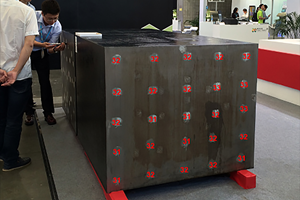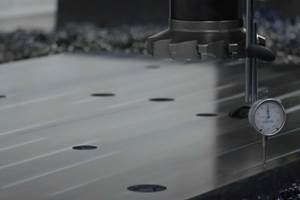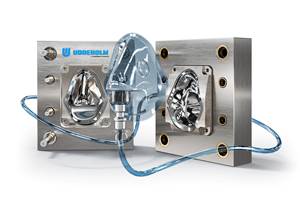With increasingly complex mold designs comes the need for mold materials that enable moldmakers to machine cores and cavities more efficiently, keep production costs down and meet short delivery times. MoldMaking Technology approached a few materials suppliers to get the latest scoop on mold material trends and the driving forces behind them.
MoldMaking Technology approached a few materials suppliers to get the latest scoop on mold material trends and the driving forces behind them.
Material Usage Trends
All five material supplier companies participating in this feature called out the resurgence in moldmakers’ use of pre-hardened materials. Rich Polenick, technical manager at Ellwood Specialty Steel (New Castle, Pennsylvania), says, “Moldmakers are looking for higher hardness levels that promote the ability to polish for critical-finish molded parts like lenses. Consumers like all the design-driven frills that are offered in the automotive sector. For example, there are these large instrument panel tools with geometric patterns, Class 8 highway trucks with large, textured internal and external parts and lens components that keep increasing in size. With all these new demands come challenges like achieving a perfect result using acid etching methods for intricate texture patterns, especially for tools that have large, molded surface areas.”
“With all these new demands come challenges like achieving a perfect result using acid etching methods for intricate texture patterns, especially for tools that have large, molded surface areas.”
Paul Britton, vice president and director at International Mold Steel Inc. (Florence, Kentucky), attributes the revival of pre-hardened materials to moldmakers’ need for quicker turnaround on lead times. He adds that customers also are looking at non-traditional mold steels for certain applications. “For example, one customer had a 48-percent glass-filled material and needed something harder than a typical H-13 or S-7 material so he would not have to coat the mold,” he says. “Others are building molds for thin-walled parts, with cores that are very thin—thin enough where, if the cores are not inserted, they will break. For that, they need something tougher because P20 or H13 just isn’t strong enough.”
John Stocker, sales director at Schmolz + Bickenbach USA (Carol Stream, Illinois), says that in addition to the increased use of pre-hardened materials, many moldmakers are looking to material suppliers for additional, value-added services like phase-one machining, which includes providing six-sided machining and holes for eyebolts. “The benefit is that they can streamline their processes by eliminating the time-consuming preparation work, which in turn enables them to use their highly skilled employees more efficiently and effectively,” he says.
Kilian Wagner, sales director at Edro Specialty Steels, exclusive distributor of Bohler tool steels in the United States (Walnut, California), says, “The introduction of low-carbon steel grades combined with new re-melting techniques (like pressurized electroslag re-melting processes (ESR)) has resulted in the development of new grades with improved toughness, cleanliness and thermal conductivity. For example, a new modified 420-type has shown similar levels of toughness (in impact-bending strength) to H13 ESR and thermal conductivity improvements that exceed 30 percent in comparison to standard 420 ESR,” he says, noting that for superior toughness, vacuum melt and re-melt (VMR) grades also are commonly used. “Other interesting developments are powder metallurgical grades and special, high-alloyed products that offer other outstanding properties for a variety of special requirements. Finally, additively manufactured mold components designed with new, conformal-cooled geometries are trending.”
As much as demand for pre-hardened materials is on the rise, Wagner says that surface treatments continue to play a critical role for moldmaking and molding. “The use of surface coatings for mold inserts is increasing, relating to features like wear resistance, part release and surface finish. More coating choices are available today that provide solutions for specific applications,” he says. For example, diamond-like carbon (DLC) coatings can provide hard substrate surfaces and are suitable for use on most materials. Also, DLC is typically applied below tempering temperatures, making it eligible for most steels.
An Education in Mold Materials
“With the market picking up and metal prices on the rise, we have seen more interest in materials education,” says David Wirth, mold plate product manager at Clinton Aluminum and Stainless Steel (Clinton, Ohio). “Metal pricing has gone up tremendously, so moldmakers are being even more diligent about finding the right aluminum alloy for the right application.” He explains that it can be a frustrating task for moldmakers to select the material that is best suited to deliver their desired results. This is because no two alloys are alike—each has its own strengths and weaknesses. It is important to understand how the varying grades of alloys react to molding temperatures. For instance, on paper, a 7,000-series aluminum product is the toughest out there, but moldmakers molding at high temperatures of about 280°F or higher will probably experience some problems regarding mechanical properties.
It is important to understand how the varying grades of alloys react to molding temperatures.
Paul Britton of International Mold Steel concurs with the steel pricing trend, saying that the industry is seeing some shortages regarding what suppliers are carrying in inventory. “Electrodes are causing the price increases because they are in short supply. Electrodes are necessary to make steel.” Graphite electrodes are the main heating element used to produce the intense heat (2,912°F) that is needed to run an electric arc furnace in a steel factory. In mid-2017, after about four years of a soft market and surplus materials, the U.S. steel industry rebounded. Still, many graphite electrode producers closed their doors. This happened domestically because of low capacity utilization and in China because environmental restrictions were put in place, and the closings caused the current shortage. “One major electrode supplier closed, and another major supplier in China is raising prices. Most of the major materials suppliers have announced price increases because of changes like this that are occurring in the steel marketplace,” he says. “Business for moldmakers seems to be steady or is even picking up, making lead times longer because of low inventory. Suppliers are simply running out, and this applies to almost every grade of steel.” To address these challenges, Britton says that International Mold Steel is increasing the tonnage on its floor and adding new equipment to keep delivery times at a minimum. “We are trying to minimize the pricing increases, but we can only absorb so much, so we are adding materials handling equipment, saws and so on to speed production and order fulfillment,” he says.
“Business for moldmakers seems to be steady or is even picking up, making lead times longer because of low inventory.”
Kilian Wagner of Edro Specialty Steels says, “Many end users specify traditional AISI-designated tool-steel grades and heat treatments for their molds. This limits the moldmakers’ own input and choice of materials. At Edro, the availability of information on new products and the technical support for these products is a core focus.” He says that soon the company will introduce several unique tool-steel grades that were developed and introduced outside of the United States over the last five to 10 years. The company will place a strong focus on education and technical training to ensure that customers know what is available and how these products can help the performance of their tooling.
Rich Polenick says that Ellwood Specialty Steel’s in-house R&D team continues to evaluate improvements in mold steels. “However, improving moldmaking, maintenance and repair or even the molding process is a tall task for steel. As in all business decisions, there is a cost-to-benefit factor,” he says. “One can use alloy steels of a higher level that may perform better in different applications, can polish more easily, texture better, run faster in a mold or have better mechanical properties, but they are more expensive than the traditional low-alloy mold steels. Cost is always a driving factor in material selection.” To assist, he says that Ellwood Specialty Steel offers group seminars to original equipment manufacturers (OEMs), Tier-1 suppliers and moldmakers to learn more about the process of steelmaking, forging and heat-treating. “This seminar also enables all parties to understand specific challenges that we all face, like mold life, maintenance or cooling and cycle time and brainstorm on innovative or collaborative ways to address these issues. Ellwood Specialty Steel has deep metallurgical experience and our doors are always open to help solve our customers’ challenges.”
Greater Acceptance of Aluminum
While tool steels remain the materials of choice for moldmaking, suppliers are noting that aluminum also continues to make a strong showing. “There is increasing interest in aluminum mold products in an array of applications,” David Wirth of Clinton Aluminum and Stainless Steel says. “For example, we were recently contacted by a blow molder interested in an alternative to an expensive, forged material. After discussing the project, we learned that the pinch area was to be inserted with beryllium copper. We then directed them to a cast aluminum product that is more readily available, easier to repair and more cost effective.” He says that cycle-time reduction is the biggest reason for choosing aluminum. “If 50 percent of the cost of a part for the OEM is press time, and it is possible to save 15–30 percent on cycle time, then that’s the motivating factor.”
Wirth adds that as the mold industry moves toward larger aluminum molds because of price, weight and cycle-time reduction, there is an increased need for thicker and wider moldmaking materials. “Clinton Aluminum now offers mold plate up to 42 inches thick,” he says. Clinton Aluminum and Stainless Steel also has recently added several new alloys that Wirth says will serve to fill the void between cast aluminum and a less available, costlier forged product when it comes to Brinell hardness and tensile strength. “Because moldmakers are pushed for faster lead times, the availability of material will be more crucial than ever,” he says.
As the mold industry moves toward larger aluminum molds because of price, weight and cycle-time reduction, there is an increased need for thicker and wider moldmaking materials.
Ellwood Specialty Steel’s Rich Polenick says that there is greater acceptance of aluminum alloys to build production molds for high-volume parts. “Aluminum alloys were traditionally used only for prototype tooling because they were easily machined and suited the need for molding limited quantities of parts. But, they were considered ‘soft’ and inappropriate for the making of long-term, high-volume parts,” he says. “Aluminum alloys have recently been developed that have been proven to be capable of high volumes and of withstanding the rigors of those processes over time.” He notes that packaging applications have used aluminum for quite some time while the automotive industry is gaining acceptance as their vehicles become more high-mix or low-volume regarding production needs. “Hardened-steel molds may not be required,” he says. “Most importantly, the higher thermal conductivity of aluminum yields the benefit of faster cycle times.”
Striving for Better Materials Performance
Polenick says that Ellwood Specialty Steel has a 108-year history in metalworking and is always working to develop better products for its customers, including ongoing testing and development of steels in the company’s core molding grades (P20, H13 and stainless steels). “Efforts are focused on the production of cleaner steels, which are those that contain fewer non-metallic inclusions that are always found in steelmaking because of the process and the alloying elements. Cleaner steels can address the aforementioned mold-finish challenges while maintaining the mechanical properties that are expected,” he says, adding that great improvements have been made by all steel producers in this. Also, the company is evaluating the expansion of its re-melt steelmaking capacity, and its research metallurgists have been exploring a grade of P20 steel (the most common grade for injection molds) that will help mitigate the risk for potential polishing or texturing issues.
Kilian Wagner of Edro Specialty Steels says that the company’s research and development team is dedicated to supporting new tool-steel product advances that deliver advantages in the areas of toughness, machinability, the ability to polish and thermal conductivity, to name a few. These advances can be found in innovative alloying concepts, new production processes, surface treatments and in the new kid on the block: additive manufacturing.
Meanwhile, International Mold Steel’s Paul Britton says that his company is working to develop more stable materials that do not move during heavy machining or welding processes, higher-hardness materials and materials with a finer grain structure. “We are always looking to bring in new products to help moldmakers with repair, maintenance and molding,” he says. Schmolz + Bickenbach USA’s John Stocker says that his company also has developed materials with machinability, mold repair and maintenance and mold performance in mind. For example, customers have access to materials with improved weldability to increase the efficiency of maintaining molds. “Because domestic moldmakers are continually challenged to reduce lead times, our company seeks to provide new materials and value-added solutions that make it possible for our customers to optimize efficiencies in the moldmaking process and improve mold performance,” he says.
Related Content
Pre-Hardened Mold Steel Material Increases Through-Hardened Ability
Finkl Steel’s patented pre-hardened mold steel grade MD Xtra material achieves high impact strength, enhanced thermal conductivity and is an exceptional solution for deep impression applications.
Read MoreWhat You Should Consider When Purchasing Modified P20 Steel
When buying P20 steels that have been modified, moldmakers must be aware of the variations and key issues that affect delivery, cost and lead times.
Read MoreHow to Produce More Accurate Molds and Reduce Rework
Patented micro-milling process for manufacturing steel plate flat and parallel helps mold builders shorten mold build times and increase accuracy.
Read MoreCorrosion-Resistant, High-Hardness Mold Steel for Optimal Surface Finishes
Uddeholm’s premium Tyrax ESR can reduce polishing time by 40-50% and is suitable for long run production molds and high-performance plastics.
Read MoreRead Next
Reasons to Use Fiber Lasers for Mold Cleaning
Fiber lasers offer a simplicity, speed, control and portability, minimizing mold cleaning risks.
Read MoreHow to Use Continuing Education to Remain Competitive in Moldmaking
Continued training helps moldmakers make tooling decisions and properly use the latest cutting tool to efficiently machine high-quality molds.
Read MoreAre You a Moldmaker Considering 3D Printing? Consider the 3D Printing Workshop at NPE2024
Presentations will cover 3D printing for mold tooling, material innovation, product development, bridge production and full-scale, high-volume additive manufacturing.
Read More


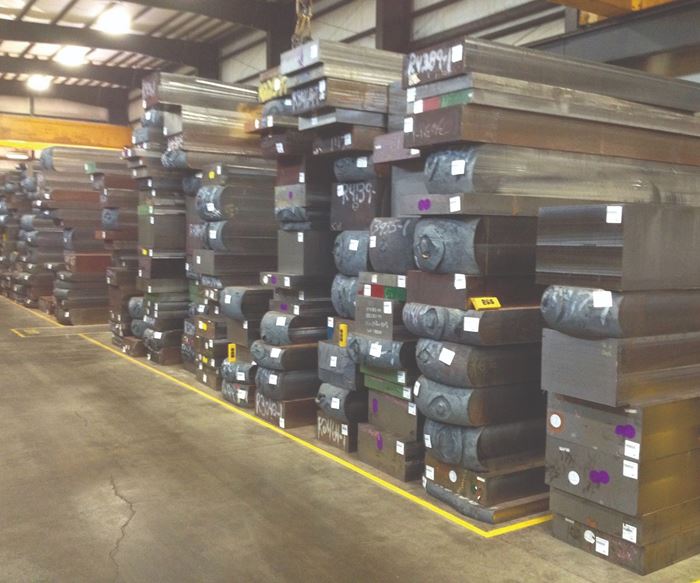
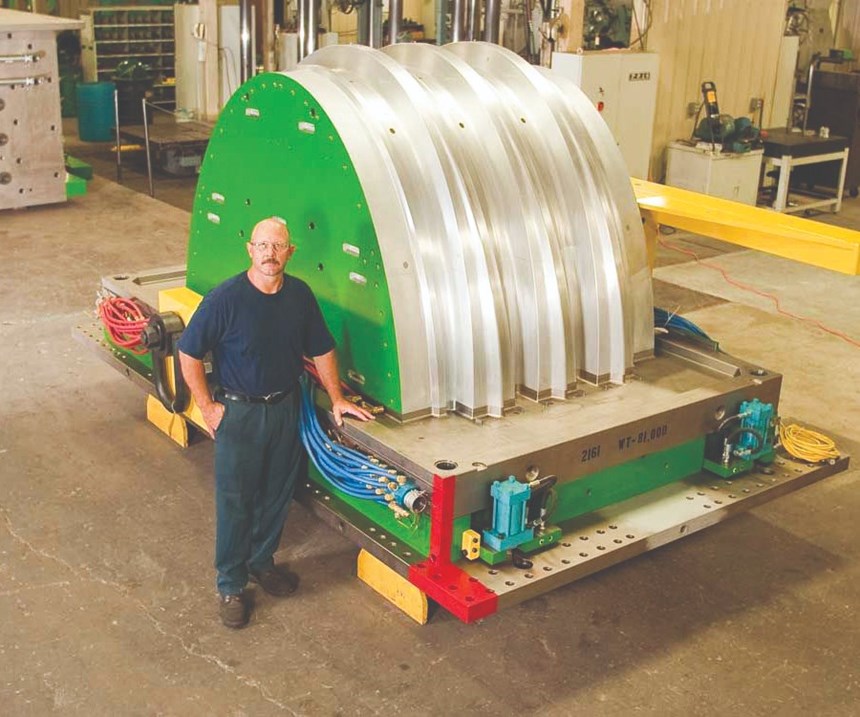







_300x250 4.png;maxWidth=300;quality=90)











.jpg;maxWidth=300;quality=90)

